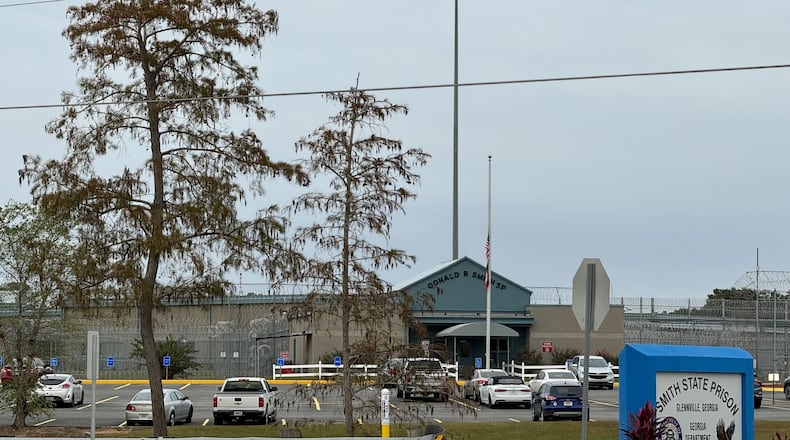The Georgia Department of Corrections revealed Monday that a “personal relationship” existed between prison inmate Jaydrekus Hart and the kitchen worker he shot and killed Sunday morning in a stunning failure of security at Smith State Prison in Glennville.
The GDC provided few details about the relationship that could be a motive in the killing of 24-year-old Aramark employee Aureon Shavea Grace. But the agency said a suicide note was discovered that appeared to have been left by Hart, 34, who turned the gun on himself after shooting Grace.
“This was an isolated incident and the investigation remains open and active,” GDC spokesperson Lori Benoit said in the statement. Benoit said the prison system would provide no further information Monday as the investigation continued.
While the GDC portrayed the incident as isolated and offered no explanation about how the inmate, who worked the kitchen detail, could obtain a loaded pistol, former GDC employees told the Atlanta Journal-Constitution about security gaps that could allow someone to smuggle in a gun.
Speculation Monday centered on a drone or the back gate, where there is no metal detector, as possible avenues for a gun entering a Georgia prison.
It would be virtually impossible to bring a weapon in the front entry because everyone — both visitors and employees —must go through a scanner that would detect metal objects. But the back gate would be vulnerable, former employees said.
Jose Morales, who served as a warden at five different GDC facilities before his retirement in 2021, said he never found or confiscated a gun in his 22 years with the GDC. But he said he can see how one can get into a prison if what comes through the back gate isn’t properly scrutinized.
“The rear gate is easily defeated,” he wrote in a text to the AJC.
A former Smith State Prison correctional officer, Julia Roberts, also pointed to potential issues at the back gate. Trucks delivering food and other supplies come through that entrance, and the pallets are not thoroughly checked, she said, in large measure because there aren’t enough officers to do it.
“There could be anything in those (containers) besides rice and beans, but they’re not opened,” she said.
Smith, like other state prisons, also battles repeated attempts to bring in contraband by drones — a problem exacerbated by the extreme shortage of correctional officers at GDC facilities.
In one such incident at Smith last August, Warden Jacob Beasley, along with agents from the GDC’s Office of Professional Standards, spotted a drone flying as they left the prison and watched it crash into the roof of a nearby residence, according to a GDC news release. The agents arrested four people as part of the incident and seized items that were suspected to be part of a contraband operation. Two loaded handguns were among those items, although it’s not clear whether the firearms were intended to be introduced into the prison.
Gov. Brian Kemp declined to comment on Sunday’s deadly shooting, citing the ongoing investigation.
The GDC didn’t answer questions Monday from the AJC about security protocols for prison staff or for prisoners who work in the kitchen area, or about whether there were any prior concerns about guns at Smith State Prison.
However, Roberts, who has filed a whistleblower lawsuit against the GDC, asserted in a recent court filing that prison officials sloughed off credible information developed in April 2022 that two handguns had been seen in one of the prison’s lockdown units.
According to the filing, Roberts was working in the prison’s mailroom when she received a note from a prisoner pointing out the existence of the guns. She turned the information over to her superiors, including a deputy warden, the filing says.
In the note, provided to the AJC by Roberts, the prisoner specifically identified the cells where the guns were located and said he’d seen one of them. The guns were never found, but Roberts contends that the search barely scratched the surface. One of the cells was never searched, nor was the prison placed on lockdown or a rapid response team called in, she claims.
Roberts said Monday that the gun issue is one that sticks out in her mind.
“I couldn’t believe we had this (note) about these two weapons and nothing was done, because I would hear about it pretty regularly from inmates that there were guns in the institution,” she said. “And they did nothing. Absolutely nothing.”
Grace’s family declined to talk with the AJC. The GDC said Sunday that her job at Aramark brought Grace to Smith State Prison in January. The GDC did not respond to questions about whether Grace had previously worked in the prison system. Records from the Georgia Peace Officer Standards and Training Council, which certifies correctional officers, show that someone with the same name had previously worked at two Georgia correctional facilities.
Hart was serving 20 years for voluntary manslaughter out of Carroll County with a maximum release date of June 2043, the GDC said. According to published reports, he was convicted in the fatal shooting of a Villa Rica man at a Memorial Day party in 2013.
Sunday’s incident is the second killing of a prison staff member within a year at Smith. In October, correctional officer Robert Clark, 42, was killed after being assaulted by a prisoner with a homemade weapon. Death certificate records show the 42-year-old suffered multiple stab wounds.
Concerns about the safety of those working in Georgia’s prisons were raised before Sunday’s deadly incident. In court filings, an executive with Wellpath, the prison system’s health care provider, said the company had trouble recruiting qualified staff to provide medical care in Georgia’s prisons because of the widespread violence, leading to additional costs to run the health care program.
Georgia prisons recorded more homicides in recent years than other state prison systems in the South, the AJC has reported. Most victims die of stabbings. Death certificate records don’t show any previous cases where a Georgia inmate fatally shot someone in a state prison.
Hugh Hurwitz, a prison management consultant and a former acting director of the Federal Bureau of Prisons, said a shooting inside a prison is extremely unusual and suggests a significant failure in security that deserves a thorough investigation.
“Potentially, the gun got in because somebody either brought it in, threw it in, flew it in or whatever, and that could be a staff member or it could be a citizen who’s still out there. I would want to know who that is,” he said.
Keep Reading
The Latest
Featured




